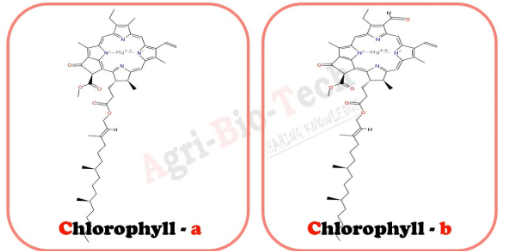Differences Between Chlorophyll a and Chlorophyll b
Leaves are green mainly because of chlorophyll, the green pigments inside the plant cell. This pigment is used by all vascular plants to convert light energy into chemical energy through photosynthesis.
Chlorophyll pigments are also involved in the photosynthesis process by absorbing the sunlight needed to make carbohydrates in plants. It is found in the thylakoid membranes of chloroplasts – green plastids that live in plant cells.
Green plants and some algae survive by making energy from sunlight, water and carbon dioxide through photosynthesis. In this process, light energy is converted into chemical energy.
In photosynthesis, water, and carbon dioxide, are converted into glucose, in the presence of sunlight; and oxygen is released into the environment.

If you look at the process of photosynthesis, you see that the main pigment that facilitates this process is chlorophyll, a green pigment. This pigment is found in some microorganisms such as cyanobacteria and within the thylakoid membranes of chloroplasts of plant cells.
These pigments absorb red and blue wavelength light rays from sunlight, which are necessary to start the process of photosynthesis.
Chlorophyll A
Chlorophyll A- This is the most abundant form of chlorophyll, which absorbs light rays of wavelengths 429 nm and 659 nm most effectively.
Chlorophyll B
Chlorophyll B- This is a type of accessory pigment that converts light energy into chlorophyll a. It is found in plants and in green algae. It absorbs light rays of wavelengths 455 nm and 642 nm.
Differences Between Chlorophyll a and Chlorophyll b
| Chlorophyll a | Chlorophyll b |
| Explanation | |
| Chlorophyll a is the primary photosynthetic pigment | Chlorophyll b is the accessory pigment |
| Presence | |
| It is present in all plants, algae, bacteria, cyanobacteria and phototrophs. | It is present only in green algae and in the plants. |
| Absorbing colour | |
| Absorbs violet-blue and orange-red light from the spectrum. | Absorbs orange-red light from the spectrum. |
| Reflecting colour | |
| It is a blue-green colour. | It is a yellow-green colour. |
| Solubility | |
| It is soluble in petroleum ether. | It is soluble in methyl alcohol. |
| Rate of Absorption | |
| Strong | Weak |
| Adsorbent | |
| It absorbs more red wavelength. | It absorbs violet-blue wavelength. |
| Energy Absorption | |
| It absorbs energy from wavelengths of blue-violet and orange-red light. | It absorbs energy from wavelengths of green light. |
| Absorption Range | |
| It absorbs the light in the range of 430 nm to 660 nm. | It absorbs light in the range of 450 nm to 650 nm. |
| In Porphyrin Ring | |
| Side groups of CH3. | CHO group is present other than CH3. |
| Photosystem | |
| It is the reaction centre of the antenna array of core proteins. | It regulates the size of the antenna. |
| Chemical formula | |
| C55H72MgN4O5 | C55H70MgN4O6 |
| Molecular weight | |
| 839.51 g/mol. | 907.49 g/mol. |
| Structural Difference | |
| Contains methyl group in the third position of its chlorine ring. | Contains an aldehyde group in the third position of its chlorine ring. |
Related Article: